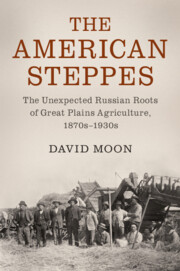Book contents
- The American Steppes
- Studies in Environment and History
- The American Steppes
- Copyright page
- Dedication
- Epigraph
- Contents
- Figures, Maps, and Tables
- Preface
- Acknowledgements
- Notes on the Text
- Dramatis Personae
- Abbreviations
- Maps
- Introduction
- Part I Contexts
- Part II Transfers
- Chapter 4 Wheat
- Chapter 5 Soil Science I
- Chapter 6 Soil Science II
- Chapter 7 Shelterbelts I
- Chapter 8 Shelterbelts II
- Chapter 9 Tumbleweed
- Conclusion
- Archival Collections Cited
- Index
Chapter 7 - Shelterbelts I
from Part II - Transfers
Published online by Cambridge University Press: 23 March 2020
- The American Steppes
- Studies in Environment and History
- The American Steppes
- Copyright page
- Dedication
- Epigraph
- Contents
- Figures, Maps, and Tables
- Preface
- Acknowledgements
- Notes on the Text
- Dramatis Personae
- Abbreviations
- Maps
- Introduction
- Part I Contexts
- Part II Transfers
- Chapter 4 Wheat
- Chapter 5 Soil Science I
- Chapter 6 Soil Science II
- Chapter 7 Shelterbelts I
- Chapter 8 Shelterbelts II
- Chapter 9 Tumbleweed
- Conclusion
- Archival Collections Cited
- Index
Summary
In 1934, the US federal government launched a project to plant shelterbelts of trees across the Great Plains to protect the land from the drying and erosive force of the wind during the Dust Bowl. There were initial hopes that the belts would moderate the climate of the region. The decision to launch the project was based, in part, on Russian experience of forestry and shelterbelts in the steppes that dated back to the early nineteenth century. One of the conduits for Russian and Soviet expertise was a Russian–Jewish émigré, Raphael Zon, who was the director of a forestry experiment station in St. Paul, Minnesota. This chapter analyzes: Russian experience of forestry and shelterbelts in the steppes; American forestry in the Great Plains before the Shelterbelt Project; and the transfer of relevant Russian experience, and Russian trees, to the United States.
- Type
- Chapter
- Information
- The American SteppesThe Unexpected Russian Roots of Great Plains Agriculture, 1870s–1930s, pp. 277 - 311Publisher: Cambridge University PressPrint publication year: 2020

